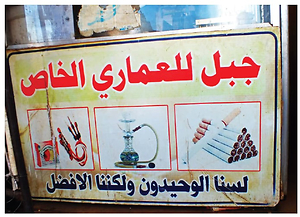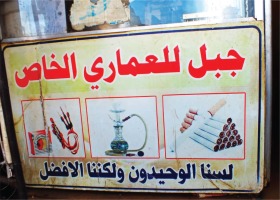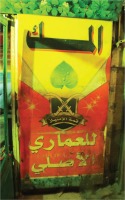INTRODUCTION
Prevention of the initiation of tobacco use is a public health priority1. Tobacco use is a preventable cause of disease, disability, and death worldwide2. Tobacco use begins during adolescence, youth and young adulthood1. World Health Organization (WHO) defines ‘Adolescents’ as individuals aged 10–19 years and ‘Youth’ as aged 15–24 years. While ‘Young’ covers the age group 10–24 years3.
WHO Framework Convention on Tobacco Control (FCTC) defined tobacco advertisement and promotion as ‘any form of communication, recommendation or action with the aim, effect or likely effect of promoting a tobacco product or tobacco use either directly or indirectly’. Article 13 further requires that parties shall prohibit all tobacco advertisement and promotion4. Exposure to tobacco advertisement and promotion is linked to the initiation of use and increase in the prevalence among adolescents5. WHO estimates that one-third of adolescents’ use of tobacco is a direct result of advertisement and promotion, and that a complete ban will decrease the tobacco epidemic5-7.
Tobacco control programs include the prohibition of all forms of advertisement and promotion, encompassing what appears on media, billboards, on packs and at point-of-sale (PoS); they are effective in reducing tobacco use as well as producing a concomitant decrease in tobacco-related health problems8.
PoS increasingly becomes an essential tool of the tobacco industry for promoting their products, due to the strict regulations on advertisement, which limit the promotional methods available to the tobacco industry9. Tobacco displays at PoS are present in most common marketing environments such as local stores, which are frequently visited by adolescents and which increase the possibility of encouraging initiation among them10,11.
Smokeless tobacco (SLT) products are mostly unmonitored, and there is a wide gap between them and smoked tobacco in terms of policy implementation, although evidence indicates that SLT use responds to control policies12,13. Moreover, SLT is promoted as being less harmful than smoking, despite its link to oral and other cancers and systemic diseases, with a reduced price and social acceptability. Therefore, there is an increase in SLT use, e.g. in the US by 62%14-16.
Sudan has a many forms of SLT known as toombak (snuff). The species Nicotiana rustica is used for the manufacture of toombak; a tobacco species with an unusually high content of nicotine and alkaloids, grown in the northwest of Sudan after the rainfall season. The plant is harvested after it turns to a yellow color and later stored for fermentation for weeks, it is then milled and stored for a year for ageing17. The product is mixed with natron (a mixture of natural forms of sodium carbonate, bicarbonate, chloride and sulfate minerals), to raise the pH for rapid absorption of the nicotine, and then water is added to the mixture, so that after about 2 hours, the mixture is ready for use18. Toombak is sold in small plastic bags each about 100 g and is used orally by insertion between lower gum and cheek or lip (dipping).
Toombak is considered as a risk factor for oral cancer because of the abnormally high concentration of tobacco specific nitrosamines, which are known to be carcinogenic, among other carcinogens produced during the fermentation, in addition to contamination and poor hygiene environment during processing17,19,20.
Among individuals aged 18 years, the average prevalence of toombak use was 38% among males and 10.9% among adolescents in Khartoum State21,22. Toombak can be purchased from many shops and the product is advertised extensively at PoS, where retailers tend to use attractive methods to draw buyers’ interest without any age restrictions17,23. The trade names for toombak include El-Sanf (of high quality), Wad Amari (name of the person who has introduced it) and Sultan El-kaif (the power to improve one’s state of mind) and other advertising to promote the strongest and powerful stimulant to change the mood17 (Figures 1 and 2).
The prevention and control of SLT use is a complex health issue and has drawn inadequate attention from researchers and policymakers worldwide24. The present study measured the association between exposure to an advertisement at PoS and toombak use among adolescents (13–15 years) in Khartoum State, Sudan. In addition, the study aimed to assess the association of toombak use with demographic factors, social acceptability, intention to use, and perceived ease of access to toombak.
METHODS
This is a cross-sectional school-based study that was conducted in 2013–14, as part of a larger research project focusing on the use of toombak among secondary school students in Khartoum State, Sudan. Khartoum is the capital of Sudan and consists of three cities (Khartoum, Omdurman, and Khartoum North), including seven localities: Khartoum, Jabal Awaliya, Omdurman, Umbadda, Karary, Bahry, and Sharg Alnil. The educational system comprises private and public schools as well as separate schools for boys and girls.
Sampling procedures
The sampling procedure was part of a larger-scale study of secondary schools students’ use of toombak21. A total of 28 schools were randomly selected, four from each locality (public/female, public/male, private/female, and private/male). All seven localities of the three cities were included in the sample. All students (census) aged 13–16 years who attended the 28 selected schools were eligible to participate in the study. Eligibility criteria required presence at the school at the time of the research and the provision by the student of informed consent. A total of 1670 students enlisted, representing an additional 9% to the calculated sample size, to account for incomplete questionnaires.
Data collection
The survey instrument was from the Global Youth Tobacco Survey (GYTS); a school-based survey designed to collect information from the students regarding exposure to the advertisement and toombak use. GYTS is an integral part of the Global Tobacco Surveillance System (GTSS), constituting questions about SLT, started by the WHO in 199925.
A self-administered questionnaire was distributed in classroom settings in the absence of teachers but under the supervision of trained data collectors after standardized instructions about the purpose of the study. A written informed consent was obtained from participating students and their parents through the schools’ administration.
Ethical clearance was obtained from the Ethical Committee of the Ministry of Health and Education, also from authorities in each locality and school. The questionnaire was translated from English to Arabic and subsequently back-translated into English by experts in both languages. A pilot study was conducted in two schools (male, female) including 60 students. It tested the accuracy of translation and understanding of the questions and was conducted before the administration of the survey in the selected schools. Based on the results of the pilot study, some minor adjustments were introduced to the survey instrument.
Questions and variables
Characteristics, including age group, parents’ employment, and parents’ education were measured. Also, exposure to toombak advertisement was measured by one question: ‘during the past 30 days did you see any toombak promotion in the toombak shops?’.
To assess social acceptability of toombak use (Cronbach’s α = 0.54), a sum variable was assessed by three questions: ‘do you think toombak helps people feel more comfortable or less comfortable at celebrations, parties, or in other social gatherings?’; ‘do you think those who are using toombak have more friends?’; and ‘do you think those who are using toombak are more attractive?’.
Exposure to toombak advertisement at PoS was measured by one question: ‘during the past 30 days did you see any toombak promotion in the toombak shops?’.
Two questions assessed the susceptibility of toombak use: ‘if one of your best friends offered you toombak, would you use it?’; and ‘at any time during the next 12 months do you think you will use toombak?’.
Perceived accessibility to toombak was measured by one question: ‘how did you get toombak last time?’. Ever users were defined as having used toombak at least once or twice in their life26.
Statistical analyses
Data were analyzed using the Statistical Package for the Social Sciences, version 20 (SPSS Inc. IL, U.S.A.). Descriptive analyses were performed using frequencies and percentages. Bivariate relationships between the dependent variable and each independent variable were assessed using cross-tabulation and chi-squared test. Multivariable analysis was conducted using multiple logistic regression. Estimates were presented as odds ratios (ORs) and 95% confidence intervals (CIs). Nagelkerkes R2 was calculated for the model.
RESULTS
A total of 1670 adolescents, aged 13–15 years, participated in the study. More than half (53.4%) were aged <15 years, and 53.6% were females (Table 1).
Table 1
Frequencies and percentages of sociodemographic characteristics of the participants
Less than half (41.8%) of the adolescents were exposed to advertisement at PoS, and 12.5% perceived direct access to toombak, and 5.3% reported that they were susceptible to use toombak, and 10.9% were ever toombak users (Table 2).
Table 2
Frequencies and percentages of characteristics of the advertisement and promotion of toombak at point-of-sale
Exposure to the advertisement of toombak at PoS was found to be associated with older age with 44.3% aged ≥15 years versus 38.9% aged <15 years reporting being exposed (p≤0.05). Males were more exposed to advertisements than females (45.2% vs 38.8%; p≤0.05). Those who were exposed to toombak advertisements at PoS reported more social acceptability towards toombak use (48.9% vs 37.6%; p≤0.001) and direct accessibility to toombak more than their counterparts (68.8% vs 47.2%; p≤0.05).
Those that perceived that they are susceptible to use toombak reported higher exposure to the advertisements than those who did not (41.7% vs 47.6), but the difference was not statistically significant. Among the toombak users, exposure to the advertisements was higher than in those who were exposed among non-users (54.5% vs 40.3%; p≤0.001) (Table 3).
Table 3
Percentages, frequencies and odds ratios with 95% CI, of demographic characteristics, social acceptability, toombak accessibility, and susceptibility and use of toombak, by advertisement and promotion
| Characteristics | Advertisement for toombak | OR (95% CI) | |
|---|---|---|---|
| Yes | No | ||
| Age (years) | |||
| <15 | 38.9 (332) | 61.1 (522) | 1.24 (1.02–1.52) |
| ≥15 | 44.3 (325)* | 55.7 (409) | |
| Gender | |||
| Female | 38.8 (336) | 61.2 (529) | 1.30 (1.06–1.58) |
| Male | 45.2 (336)* | 54.8 (407) | |
| Social acceptability of toombak user | |||
| No | 37.6 (366) | 62.4 (608) | 1.58 (1.29–1.95) |
| Yes | 48.9 (287)** | 51.1 (300) | |
| Perceived accessibility to toombak | |||
| Direct | 68.7 (22)* | 31.3 (10) | 0.40 (0.18–0.89) |
| Indirect | 47.2 (109) | 52.8 (122) | |
| Susceptibility to use toombak | |||
| No | 41.7 (622) | 58.3 (871) | 1.27 (0.82–1.97) |
| Yes | 47.6 (40) | 52.4 (44) | |
| Ever toombak use | |||
| Non-user | 40.3 (574) | 59.7 (850) | 0.56 (0.41–0.77) |
| Ever user | 54.5 (96)** | 45.5 (80) | |
The parameters associated with ever use of toombak were assessed through a regression analysis. Taking into account the respondents age, gender, social acceptability, perceived accessibility and exposure to the advertisement of toombak at PoS, the model explained 5.8% of the variance (Nagelkerke’s R2=0.058). Male and older aged respondents were more likely to be exposed to toombak advertisement at PoS (Table 4). Those perceived to have direct accessibility had a greater likelihood to be exposed to an advertisement than their counterparts (OR=2.14; 95% CI: 0.94–4.88) (Table 4).
Table 4
Ever toombak use regressed upon age group, gender, social acceptability, perceived accessibility and susceptibility of toombak use, and exposure to advertisement of toombak at point-of-sale
DISCUSSION
This study examined the possible association between exposure to toombak advertisement at PoS and its use and other related variables among adolescents in Khartoum State, Sudan. The PoS environment regarding promotion and advertisement restrictions is often overlooked in tobacco control programs, especially in Sudan. Besides, no previous study has focused on the effect of advertisement at PoS on toombak use.
In this study, less than half of the adolescents reported exposure to advertisements of toombak at PoS. This is similar to a study from Indonesia, where less than half of the participants reported exposure to SLT at PoS27. However, in India, 59% of the participants reported exposure to PoS advertisement while more than two-thirds of adolescents in New Zealand noticed displays and advertisements of tobacco products6,28.
The advertisement at PoS aims to increase product exposure, visibility and normalization of the tobacco product, and this occurs through the principles of inform, promote, create interest and curiosity, encourage trial and experimentation, and thus in an underestimate of its health hazards9,29. It seems that the exposure of male adolescents to the advertisement at PoS is higher than for females, and this is reflected in this study, where cultural and social reasons may explain this, as male adolescents are more likely to spend time outdoors than females30,31.
In Sudan, there are real challenges for enforcing prohibitions on advertising at PoS, as the law bans advertising at PoS for smoked tobacco but not toombak; also, there are no exact data on compliance to this law8,20. A report reveals that only 9% of the countries have high compliance related to the ban on advertisement, promotion and sponsorship of SLT, even though 30% have implemented a comprehensive ban at PoS13.
Evidence provided in the literature confirms that adolescents who are exposed to tobacco advertising, or are receptive to it, are more likely to have tried tobacco or have become users32-34. The current study showed a significant association between toombak users and the exposure to the advertisement of toombak at PoS. Moreover, this study reported that noticing PoS displays more frequently is associated with an increased likelihood of reporting direct access to toombak, which in turn leads to an increase in the susceptibility of Sudanese adolescents to toombak and eventually to becoming users21.
Nevertheless, in the logistic regression model, the exposure to the advertisement of toombak at PoS was not a strong predictor of becoming a future user, but the likelihood was increased 1.5 times21. This agrees with other studies where SLT susceptibility and use were associated with increased exposure to PoS display35,36, but in contrast to a study from India where a ban was associated with reduced SLT use but not with susceptibility and perceived easy access37.
This study showed higher social acceptability among adolescents who reported exposure to the advertisement, and that is supported by the change in the marketing industry’s desire for promoting SLT as a more socially acceptable product that can be used indoors38. Also, tobacco users who sometimes use other products individually or within their peer network, are associated with more favourable perceptions of SLT39.
Strengths and limitations
There are distinct strengths and limitations to this study. The study is a cross-sectional school-based sample in Khartoum State, therefore limiting the generalizability and precluding causal inferences to other parts of the country. Nevertheless, Khartoum State is highly populated and represents the ethnic and cultural diversity of the country; it provides valuable information about toombak use and advertisement at PoS and adolescents’ toombak use. The large sample size, randomization of the participants, and the reliability and validity of the questions used, are strengths of the study.
CONCLUSIONS
The exposure to the advertisement of toombak at PoS among male and older adolescents was found to be high and associated with increased toombak use in Khartoum State, Sudan. This was in addition to increasing the social acceptability of its use and perceived easy accessibility. The advertisement and promotion at PoS of toombak need attention to enforce the law, which bans it.




